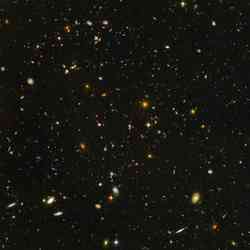
This view of nearly 10,000 galaxies is the deepest visible-light image of the cosmos. Image credit: Hubble. Click to enlarge
One of the fastest supercomputers in the world and the first ever designed specifically to study the evolution of star clusters and galaxies is now in operation at Rochester Institute of Technology.
The new computer, built by David Merritt, professor of physics in RIT?s College of Science, uses a novel architecture to reach speeds much higher than that of standard supercomputers of comparable size.
Known as gravitySimulator, the computer is designed to solve the ?gravitational N-body problem?. It simulates how a galaxy evolves as the stars move about each other in response to their own gravity. This problem is computationally demanding because there are so many interactions to calculate requiring a tremendous amount of computer time. As a result, standard supercomputers can only carry out such calculations with thousands of stars at a time.
The new computer achieves much greater performance by incorporating special accelerator boards, called GRAPEs or Gravity Pipelines, into a standard Beowulf-like cluster. The gravitySimulator, which is one of only two machines of its kind in the world, achieves a top speed of 4 Teraflops, or four trillion calculations per second, making it one of the 100 fastest computers in the world, and it can handle up to 4 million stars at once. The computer cost over $500,000 to construct and was funded by RIT, the National Science Foundation, and NASA.
Since gravitySimulator was installed in the spring, Merritt and his associates have been using it to study the binary black hole problem- what happens when two galaxies collide and their central, supermassive black holes form a bound pair.
?Eventually the two black holes are expected to merge into a single, larger black hole,? Merritt says. ?But before that happens, they interact with the stars around them, ejecting some and swallowing others. We think we see the imprints of this process in nearby galaxies, but so far no one has carried out simulations with high enough precision to test the theory.?
Merritt and his team will also use gravitySimulator to study the dynamics of the central Milky Way Galaxy in order to understand the origin of our own black hole.
Merritt sees the gravitySimulator as an important example of RIT?s development as a major scientific research institute. ?Our unique combination of in-class instruction, experiential learning and research will be a major asset in the continued development of astrophysics and other research disciplines here at RIT,? Merritt says. ?The gravitySimulator is the perfect example of the cutting edge work we are already doing and will be a major stepping stone for the development of future scientific research.?
Original Source: RIT News Release
